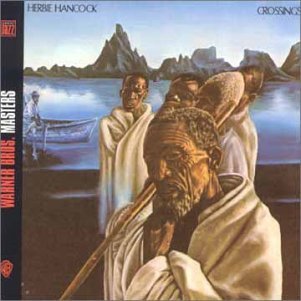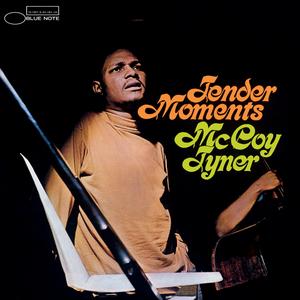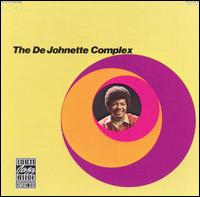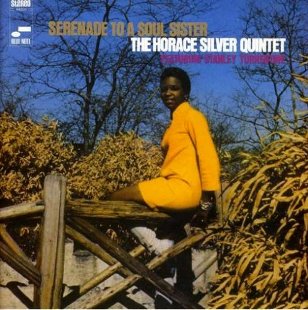
Head Hunters is the twelfth studio album by American pianist, keyboardist and composer Herbie Hancock, released October 26, 1973, on Columbia Records. Recording sessions for the album took place in the evening at Wally Heider Studios and Different Fur Trading Co. in San Francisco, California. The album was a commercial and artistic breakthrough for Hancock, crossing over to funk and rock audiences and bringing jazz-funk fusion to mainstream attention, peaking at number 13 on the Billboard 200. Hancock is featured with his ‘Mwandishi’ saxophonist Bennie Maupin and new collaborators – bassist Paul Jackson, percussionist Bill Summers and drummer Harvey Mason. The latter group of collaborators, which would go on to be known as The Headhunters, also played on Hancock's subsequent studio album Thrust (1974). All of the musicians play multiple instruments on the album.

Secrets is a jazz-funk fusion album by keyboard player Herbie Hancock. It is also Hancock's seventeenth album overall. Participating musicians include saxophonist Bennie Maupin and guitarist Wah Wah Watson.

Sextant is the eleventh studio album by Herbie Hancock, released in 1973 by Columbia. It is the last album with the Mwandishi-era sextet featuring saxophonist Bennie Maupin, trumpeter Eddie Henderson, trombonist Julian Priester, bassist Buster Williams and drummer Billy Hart. Synthesizer player Patrick Gleeson and percussionist Buck Clarke also appear.

Mwandishi is the ninth album by jazz pianist Herbie Hancock, released in 1971. It is the first album to officially feature Hancock’s ‘Mwandishi’ sextet consisting of saxophonist Bennie Maupin, trumpeter Eddie Henderson, trombonist Julian Priester, bassist Buster Williams and drummer Billy Hart.

Thrust is the fourteenth studio album by American jazz-funk musician Herbie Hancock, released in September 1974 on Columbia Records. The album reached No. 2 on the Billboard Top Soul Albums chart and No. 13 on the Billboard 200 chart. It is the second album featuring The Headhunters: saxophonist Bennie Maupin, bass guitarist Paul Jackson, drummer Mike Clark and percussionist Bill Summers.

Mr. Hands is the twenty-fourth album by Herbie Hancock. Unlike the preceding album, 'Monster', which was conceptualized as a dance album, 'Mr. Hands' is a collection of different musical styles with distinct groups. It features bass guitarist Jaco Pastorius on the track "4 A.M.," plus multiple guests including Bennie Maupin, Sheila E. and Ron Carter, plus an all-synthesizer track ("Textures") performed entirely by Hancock. "Shiftless Shuffle" was recorded by the members of The Headhunters quintet in 1973 during the sessions for the album Head Hunters. This album was the first on which Hancock used a computer, this time an Apple II. He would continue his relationship with Apple Computer for many years.

Man-Child is the fifteenth studio album by jazz pianist Herbie Hancock. The record was released on August 22, 1975 by Columbia Records. It was the final studio album to feature The Headhunters, and a number of guest musicians including saxophonist Wayne Shorter, a full brass section, three different guitarists, and Stevie Wonder on harmonica.

Crossings is the tenth album by jazz pianist Herbie Hancock, released in 1972. It is the second album in his Mwandishi period, which saw him experimenting in electronics and funk with a sextet featuring saxophonist Bennie Maupin, trumpeter Eddie Henderson, trombonist Julian Priester, bassist Buster Williams and drummer Billy Hart. The album is the band's first to feature synthesizer player Patrick Gleeson. He was scheduled to "set up his Moog for Hancock to play." However, Hancock was so impressed with Gleeson that he "asked Gleeson not only to do the overdubs on the album but join the group."

Fat Albert Rotunda is the eighth album by jazz keyboardist Herbie Hancock, released in 1969. It was Hancock's first release for Warner Bros. Records after his departure from Blue Note Records. The music was originally done for the TV special Hey, Hey, Hey, It's Fat Albert, which later inspired the Fat Albert and the Cosby Kids TV show.

V.S.O.P. is a 1977 double live album by keyboardist Herbie Hancock, featuring acoustic jazz performances by the V.S.O.P. Quintet, jazz fusion/ jazz-funk performances by the ‘Mwandishi’ band and The Headhunters. The concert was advertised as a "Herbie Hancock Retrospective," and Miles Davis, who was several months into his temporary retirement, was advertised as playing with the V.S.O.P. group. According to concert attendees, on the night of the show a handwritten sign was posted on the lobby door announcing that Davis would not be playing, but that Hubbard would be appearing instead.

Live at the Lighthouse is a live album by jazz trumpeter Lee Morgan, released on the Blue Note label in 1971. The album features a quintet of Morgan, Bennie Maupin, Harold Mabern, Jymie Merritt, and Mickey Roker, recorded at The Lighthouse in Hermosa Beach, California in July 1970. Originally released as a double LP comprising four side-long recordings, the 1996 CD reissue expanded the track list with over one-hundred minutes of additional material from the Lighthouse gigs. In 2021, Blue Note released an 8-CD/12-LP box set featuring the complete recordings of Morgan's three-night stint to commemorate the original album's fiftieth anniversary.

Tender Moments is the eighth album by jazz pianist McCoy Tyner and his second released on the Blue Note label. It was recorded in December 1967 and features performances by Tyner with an expanded group featuring trumpeter Lee Morgan, trombonist Julian Priester, French horn player Bob Northern, tuba player Howard Johnson, alto saxophonist James Spaulding, tenor saxophonist Bennie Maupin, bassist Herbie Lewis and drummer Joe Chambers.

The DeJohnette Complex is the debut album by Jack DeJohnette featuring Bennie Maupin, Stanley Cowell, Miroslav Vitous, Eddie Gómez, and Roy Haynes recorded in 1968 and released on the Milestone label in 1969.

Serenade to a Soul Sister is an album by jazz pianist Horace Silver released on the Blue Note label in 1968, featuring performances by Silver with Charles Tolliver, Stanley Turrentine, Bennie Maupin, Bob Cranshaw, John Williams, Mickey Roker and Billy Cobham.

Lift Every Voice is a studio album by American jazz pianist Andrew Hill featuring performances recorded in 1969 and released on the Blue Note label in 1970. The original album features Hill with a large choir performing five original compositions and the 2001 CD reissue added six additional compositions recorded in 1970 as bonus tracks.

Slow Traffic to the Right is the second album by jazz woodwind player Bennie Maupin, released in 1977.

Leaving This Planet is a double album by organist Charles Earland that was recorded in 1973 and released on the Prestige label.

Inside Out is an album by American jazz trumpeter Eddie Henderson recorded in 1973 and released on the Capricorn label.

Realization is the debut album by American jazz trumpeter Eddie Henderson recorded in 1973 and released on the Capricorn label.

Mahal is an album by American jazz trumpeter Eddie Henderson recorded in 1978 which was his second album released on the Capitol label.




















